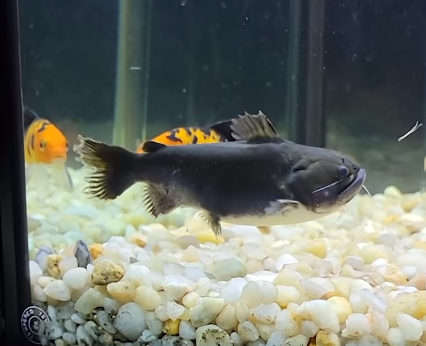Native to the freshwater streams of Rio Negro and Orinoco river basins in Brazil, Colombia, and Venezuela, Gulper catfish are strictly carnivorous creatures that feed on smaller fish, crustaceans, and insects.
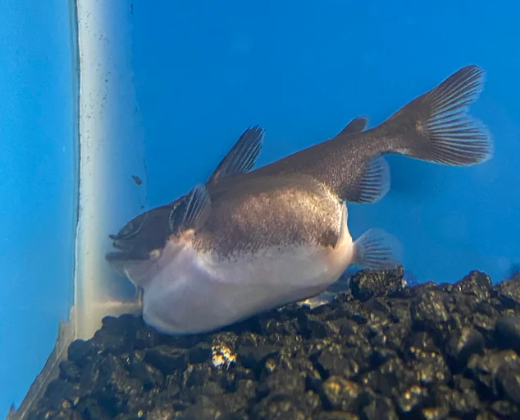
The Gulper catfish can grow up to 15 inches long in the wild. Their growth, however, encumbers in captivity. They have large mouths and sharp teeth to support their ambush predation strategies.
In this article, we’ll discuss the proper care routines for Gulper catfish and share a few pro tips that may help you.
Table of Contents
Gulper Catfish Overview
The nocturnal gulper catfish is a territorial fish and prefers to swim around the tank during the night. During the day, they stay dormant at the bottom of the tank in the shade of driftwood and caves.
Gulpers being scaleless, you must offer a smooth sand-based substrate to prevent damaging the Gulper’s sensitive underbelly and soft body. As for tank sizes, many aquarists argue that a 40-50 gallon tank is enough to sustain Gulpers, but we recommend going overboard to offer at least 75 gallons of water for them to explore and swim around.
| Information Chart | Gulper Catfish |
| Scientific Name: | Asterophysus batrachus |
| Family: | Auchenipteridae |
| Care Level: | Intermediate to Advanced |
| Temperament: | Solitary, territorial, aggressive |
| Color: | Dark brown or black with white spots |
| Lifespan: | 10 – 15 years |
| Size: | 12 to 14 inches |
| Diet: | Strict carnivorous diet. They prefer live and frozen fish, shrimp, and other protein-rich food |
| Minimum Tank Size: | 75 – 100 gallons |
| Temperature: | 75 to 82F |
| WaterConditions: | pH: 6.0 to 6.5Soft water hardness |
| Tank Mate Compatibility | Best kept alone or in large predator tanks |
Gulper Catfish Appearance
Gulper catfish have a typical catfish-like appearance with a flat body, downturned mouth, and whiskers. They mostly have a black or brown body with a pale, softer underbelly. The gulpers are known for their terrible eyesight and it shows in their cloudy pale eyes.
In artificial waters, Gulper catfish seldom grow over 11 inches, but there are several instances of them growing over 14 inches. While they’re decent in size, their fins are small and have sharp rays on their pectoral and dorsal fins.
Their broad caudal fin and pelvic fins allow them to maneuver effortlessly in the water. However, be careful not to touch the sharp rays on the fins to avoid puncturing yourself. Consider avoiding sellers who clip the rays of the fish. This can cause infections and reduce the lifespan of your fish.
Types of Gulper Catfish
There aren’t any significant type differences between Gulpers sourced from different locations, but some have an orange hue on their body—making them more suitable for aquarium trade.
Gulpers are pretty hard to breed. The shortage of variations can be attributed to the lack of captive breeding and the minimal requirement for adaptability in their natural habitat.
Lifespan of Gulper Catfish
With proper enrichment and maintenance, Gulper Catfish can live up to 15 years in artificial waters. However, their lifespan can be influenced by various factors, including:
- Water quality
High ammonia or nitrite levels can stress your gulper and hinder its physiological functions to the extent of infections and premature death.
- Tank size
Keeping fish in smaller tanks than required may develop muscle entropy. Providing a tank big enough for the Gulper Catfish to swim freely and explore is critical to maximize its lifespan.
- Diet
A proper carnivorous diet of fresh protein is essential to sustain Gulper Catfish. Feeder fish are the best alternative for that purpose, but they must be quarantined to avoid parasites before being fed to the Gulper.
If possible, breed your own feeder fish in a healthy environment to avoid the risk of contamination.
Other alternatives may include shrimp, commercial carnivorous pellets, and frozen food.
Gulper Catfish Size
In captivity, Gulper Catfish seldom grows beyond 12 -14 inches. Nonetheless, they need adequate swimming space, hunting grounds, and a consistent supply of nutrition to achieve that size.
As mentioned, nutrition and tank size play critical roles in determining their lifespan and size. Expert aquarists feed rapidly growing Gulper Catfish live goldfish till they’re around 12 inches in size, and pivot to shrimp and pellets afterward to maximize their growth.
Keeping a healthy tank also contributes to the overall health and size of Gulper Catfish.
Gulper Catfish Natural Habitat and Origin
Inhabiting slow-moving blackwater and clearwater tributaries, floodplains, and lagoons in the Amazon and Orinoco river basins, the Gulper Catfish prefers areas with dense vegetation and abundant food.
They often hide in areas with submerged root systems and underwater structures to ambush their prey and occasionally hide from danger.
Sandy and muddy substrates are mostly recommended for the Gulper Catfish due to their delicate underbelly. But, as they don’t exhibit burrowing or scavenging behavior that can harm their mouth and body, smooth pebbles and rocks can be used for the same.
Gulpers don’t have any designated predators in their natural habitat. However, juvenile Gulpers may get eaten by larger aquatic creatures.
Gulper Catfish Care & Tank Set-Up
Gulper Catfish thrives in slow-moving freshwater streams where the water quality is consistently maintained through natural processes. They also have a large body-to-tank ratio to support their active swimming habits.
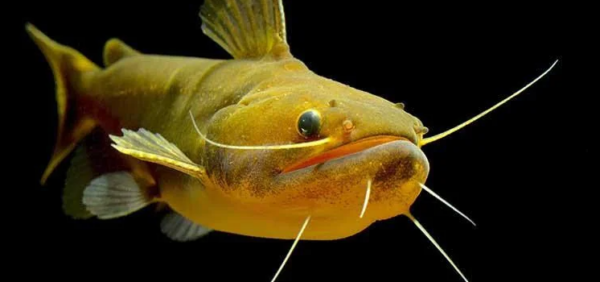
Therefore, tank set-up and proper care are paramount to keep Gulper Catfish.
1. Gulper Catfish Tank Size and Specifications
Tank size and tank specifications are the cornerstones of setting up the tank for your preferred fish species. The key elements of the same are discussed here.
Optimum Tank Size for Gulper Catfish
While seeming redundant, a 75 to 100-gallon tank is optimum for a Gulper Catfish. This is to compensate for their need for active swimming and live feeding habits.
While it’s best to keep only a single Gulper in a tank, it’s not always practical. Many aquarists prefer keeping predatory fish together in larger tanks or ponds.
Gulpers, being smaller in size and quite aggressive, need large ponds to survive with other predatory fish species.
Tank Shape for Gulper Catfish
Rectangular prism tanks are optimum for Gulper Catfish. With their longer horizontal stretch, these tanks allow a much broader swimming space for your Gulper. As you may find it difficult to buy a premade 100-gallon aquarium, here are a few rough estimates for you to start:
- 75 gallon dimension: 48″ x 18″ x 21″
- 90-gallon dimension: 48″ x 18″ x 24″
- 125-gallon dimension: 67″ x 18″ x 24″
- 150-gallon dimension: 72″ x 18″ x 28″
Filter Type
Carnivorous fish species, such as Gulper Catfish, create a lot of bioload in the form of uneaten food and feces. Filtration requirements for Gulper tanks, therefore, are pretty demanding.
Consider using substrate and internal filters to trap the larger organic debris left behind, and use a high-powered canister filter to maintain water quality and trap smaller particles. As your tank would be large, invest in premium products from Fluval or Marineland for the best results.
Another reason to use a high-powered canister filter is to see your Gulper swim against the flow. They love to dart in and out of the current. You can, nonetheless, achieve the same with flow generators.
Substrate
Use commercial sand and soil-based substrates in Gulper Catfish aquariums. A sand and soil mixture is better if you are looking to grow aquatic plants in the tank. Plants provide the necessary hiding places for the Gulpers to ambush and hide.
How many Gulper Catfish can be kept in a 75-gallon tank?
An individual Gulper Catfish can be kept in a 75-gallon tank.
2. Water Parameters for Gulper Catfish
The water parameters suitable for Gulper Catfish are as follows:
Water Temperature
Situated in the tropical climate zone, the natural habitat of Gulper Catfish is characterized by high temperatures and significant rainfall. You need to closely follow this temperature spectrum in your aquarium and keep it between 75 to 82 degrees F (23 to 27 degrees C).
In the winter months, a capable heater with a thermostat should suffice, but in summer, try to facilitate frequent water changes and increase the water flow to bring down the water temperature.
Water Flow Rate
Gulpers come from slow-moving or stagnant water bodies. While they prefer to keep swimming at their own pace, Gulpers love exploring places with high currents. With tanks larger than 75 gallons, there is no need to shy away from using a powerful flow generator or powerheads to provide adequate flow to keep your Gulper entertained.
If you’ve kept your Gulper Catfish in a larger aquarium (over 75 gallons), a flow rate of 300-400 GPH should be adequate.
pH Level
Gulper Catfish prefer slightly acidic 6.0 to 6.5 pH levels. Although they’re pretty resilient to pH changes in their natural environment, they can develop stress-related issues and end up with a weakened immune system.
Avoid pH spikes in your aquarium by following these tips:
- Know your water source. Always test your tap water before using it for water changes. Most areas change their water source in winter.
- Monitor pH levels regularly. Get yourself a handy digital pH meter and keep it probed in the water.
- Use commercial pH buffers as instructed by the manufacturer.
- Use RO water whenever possible, but reduce its pH to similar levels before introducing it to the tank.
Water Hardness
A water hardness of 2-10 DGH is preferred by Gulper Catfish. Most filtered tap water and RO water should be adequate for this purpose.
3. Gulper Catfish Tank Landscape
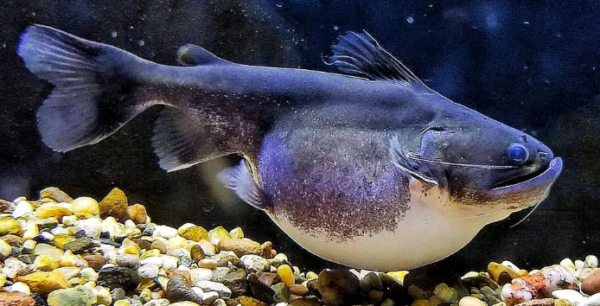
Focus on emulating the natural environment in the tank for your Gulper Catfish to thrive.
Best Plants for Gulper Catfish Tanks
Here are a few plants that are suitable for Gulper tanks:
Choose only plants that have similar parameter requirements, temperature, and lighting requirements as Gulper Catfish.
Worst Plants for Gulper Catfish Tanks
Most plants aren’t suitable to be kept in Gulper Catfish tanks. They potentially can uproot and damage the plants due to their predatory and active nature. Some types of plants that are ill-suited for Gulpers, are:
- Delicate plants such as Hairgrass and carpeting plants aren’t suitable for such hostile environments. Additionally, being bottom-dwellers, Gulpers may also disturb these plants frequently.
- Stem plants like Hygrophila and Rotala species can be easily uprooted and nibbled on by the catfish.
- Floating plants, including Frogbit and Water Lettuce, may occasionally get disturbed by your Gulper Catfish.
Decorations for Gulper Catfish Tanks
As they inhabit areas with submerged structures like roots and driftwood, decorations are pretty important for Gulper Catfish. Some aesthetic yet functional decorations may include:
- Driftwood
Large pieces of driftwood can serve as both decorative items and ambush elements. Driftwood also helps lower the pH in the tank.
- PVC Structures
You can strategically place PVC-made structures to emulate the natural cave forms in the wild.
- Rockwork
Sturdy rocks and caves can offer excellent hiding spots for the Gulpers. Make sure they don’t have any sharp edges.
Lighting for Gulper Catfish Tanks
Gulpers are predominantly nocturnal creatures. They hide and stay partially inactive during the daytime to become active at night. Lighting should be as minimal as possible with 10-hour cycles of strong and dim radiance.
Feeding Gulper Catfish
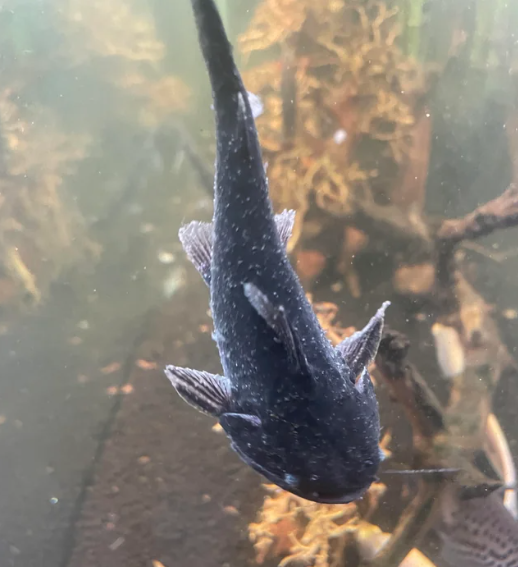
Most beginner aquarists fail to take care of Gulper Catfish because of their nutritional demands. A strict carnivorous diet needs to be followed when keeping Gulpers. Nevertheless, they often refuse to eat shrimp and carnivorous pellets to feed on live fish. Which, undoubtedly, is pretty challenging to safely deliver to the tank.
Best Diet for Gulper Catfish
The best diet for Gulpers includes:
Feeder Fish
Goldfish or Minnows make the best feeder fish. They’re easy to source and even breed. They also are pretty acceptable to Gulpers for their slow movement and rich nutritional value.
However, stay cautious of parasites and bacteria when feeding live fish to your Gulper. Quarantine new batches of feeder fish for at least a week to remove any weak or infected fish. If you’re breeding your own, consider keeping a healthy environment for the goldfish and minnows to build their immunity.
We feed live fish to our Gulpers till they’re around 12 inches in length and growing rapidly. Thereafter, we move to shrimp and carnivorous pellets.
If your Gulper refuses to eat anything except live fish, hand feed the feeder fish by holding them by the tail. Introduce shrimp and other alternative food similarly once your Gulper gets accustomed to the routine.
Gutloaded Creatures
Although Gulper Catfish are carnivorous, they still can extract benefits from vegetable matter. Gutloading is meant to make your Gulper Catfish voluntarily ingest the same.
You need to feed high-quality pellets, flakes, and prepared food to the feeder fish till their bellies are plump. Feed them to your Gulper Catfish within an hour of gutloading to maximize the effectiveness of the technique.
You may also gutload other aquatic creatures, such as shrimp, amphibians, and worms.
Alternative Food
Alternative foods are always recommended by our experienced fishkeepers. High-quality pellets, granular food, and kibble-type foods are safe and quite nutritional for Gulper Catfish.
How often should you feed Gulper Catfish?
If your Gulper Catfish can eat moderately bigger fish, you don’t need to regularly feed it. Gutload and feed a large feeder fish every 2-3 days to allow it to digest and be prepared for another frenzy.
On the other hand, if your Gulper is reliant on pellets and frozen food, you can feed it once daily.
Given the opportunity, this species of catfish can overfeed themselves. Impose volume and time restrictions when feeding your Gulper.
Gulper Catfish Tank Mates
Gulper Catfish are pretty hostile towards any tank mates. They either attack other inhabitants or stress themselves to the point of inactivity. They also don’t like to be around individuals of their own species.
Therefore, experts recommend keeping Gulper Catfish in its own tank.
Breeding Gulper Catfish
Captive breeding of Gulper Catfish is neither very successful nor common. While there have been instances of Gulpers mating, successful egg-laying or hatching are pretty rare.
Gulper Catfish Common Disease and Their Treatment
Common aquarium diseases often affect Gulper Catfish due to their sensitive skin and injury-prone predation techniques. The typical Gulper diseases may include:
- Ich
White cysts or spots may develop on the fins and body. Increased mucus production and rubbing against objects are prominent symptoms of this disease. General treatment involves raising the aquarium temperature and treating it with copper-based medication.
- Fin Rot
Decaying fins, fatigue, and inflammation are common symptoms of fin rot disease. Antibiotics are pretty effective against this disease.
- Fungus
Usual symptoms include cotton-like growth on the skin, gills, and fins. Antifungal medications and frequent water changes are effective treatment options.
Facts About Gulper Catfish
- Gulper Catfish are ambush predators. They quickly engulf prey in a matter of seconds with their large mouths.
- They produce an audible clicking sound when hunting. This serves as a warning to other fish.
- Their dark, mottled coloration provides excellent camouflage in their natural habitat.
- Gulper Catfish can gulp air at the water’s surface.
- They are primarily nocturnal. They’re most active at night when they hunt and feed.
- Gulper Catfish are known for their territorial and aggressive behavior.
- They can reach sizes of 12-16 inches or larger in captivity.
FAQs
Gulpers can grow to a respectable 12-14 inches in captivity. However, due to the lack of proper nutrition and care, they seldom grow beyond 10 inches.
Yes, Gulper Catfish are pretty aggressive. They’re best to be left alone in solitary tanks.
Theoretically, you can keep Gulpers with other fish in large predator ponds, but most aquarists don’t have the patience or knowledge to sustain such environments.
The Bottom Line
We’ve discussed the complete guide to Gulper Catfish care in this article. Hopefully, you’ll now be able to keep your Gulper happy and healthy for years to come.
No related posts.

